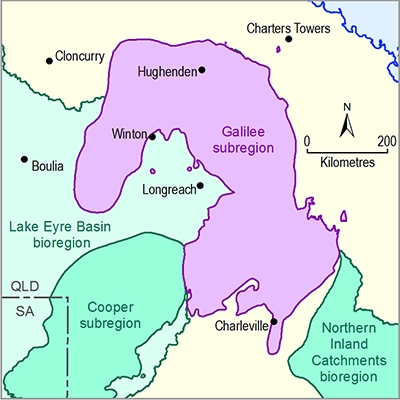Summary
The conceptual model of causal pathways characterises the causal pathway, the logical chain of events – either planned or unplanned – that link coal resource development and potential impacts on water resources and water-dependent assets. This section details the specific application to the Galilee subregion of methods described in the companion submethodology M05 (as listed in Table 1) for developing a conceptual model of causal pathways (Henderson et al., 2016).
Key concepts and terminology are also explained, and the overall steps are summarised: (i) synthesis of key system components, processes and interactions for the geology, hydrogeology and surface water of the subregion; (ii) landscape classification; (iii) definition of the coal resource development pathway (CRDP); (iv) hazard analysis; (v) identification of causal pathways from the coal resource development to hydrological changes; and (vi) description of the resulting causal pathways for the CRDP for the Galilee subregion.
The Galilee subregion is a greenfield coal resource development area. The regional hydrogeological conceptualisation (Section 2.3.2) is a first for the geological Galilee Basin and demonstrates many important hydrogeological features of the subregion, including how groundwater flow systems may interact with aquifers in the overlying Eromanga Basin. Section 2.3.2 also highlights existing knowledge gaps and uncertainties in the conceptualisation of the subregion.
The landscape classification (Section 2.3.3) for the Galilee subregion characterises the nature of water dependency for assets identified in companion product 1.3 for the Galilee subregion (Sparrow et al., 2015). The aim of the landscape classification is to systematically define geographical areas into classes based on similarity in physical and/or biological and hydrological character. The objective of the landscape classification is to present a conceptualisation of the main biophysical and human systems at the surface and describe their hydrological connectivity.
There were no commercially producing coal mines or coal seam gas (CSG) fields as of December 2012 in the Galilee subregion. Hence there are no coal mines or CSG fields included in the baseline coal resource development (baseline). However, the Assessment team’s evaluation of the potential coal resource developments listed in companion product 1.2 for the Galilee subregion (Lewis et al., 2014) was used to determine the CRDP. There are 14 identified coal resources included in the CRDP for the Galilee subregion, of which the 7 most advanced coal mining proposals have sufficient data and information available for them to be included in the quantitative (modelled) assessment of potential cumulative impacts to water resources. Three CSG projects are also included in the CRDP, although none are sufficiently well advanced in their appraisal, planning or various regulatory assessment processes to be included in the modelled assessment for the Galilee subregion.
The magnitude of potential hydrological change relating to coal mine developments in the modelled CRDP is quantified through modelling outlined in companion product 2.6.1 (Karim et al., 2018) and companion product 2.6.2 (Peeters et al., 2018) for the Galilee subregion. Product 2.7 (receptor impact modelling) will utilise the landscape classification as a basis to quantify the magnitude and uncertainty of hydrological changes and how it will propagate through ecological systems. Quantified impacts and risks resulting from hydrological changes will be outlined in product 3-4 (impact and risk analysis). Product 3-4 (impact and risk analysis) will also include commentary on the potential impact of coal resource developments that are not included in the modelled CRDP.

Product Finalisation date
- 2.3.1 Methods
- 2.3.2 Summary of key system components, processes and interactions
- 2.3.3 Ecosystems
- 2.3.4 Baseline and coal resource development pathway
- 2.3.5 Conceptual model of causal pathways
- Citation
- Acknowledgements
- Currency of scientific results
- Contributors to the Technical Programme
- About this technical product
